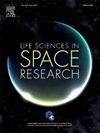Organ dose equivalents of albedo protons and neutrons under exposure to large solar particle events during lunar human landing missions
Abstract
Astronauts participating in lunar landing missions will encounter exposure to albedo particles emitted from the lunar surface as well as primary high-energy particles in the spectra of galactic cosmic rays (GCRs) and solar particle events (SPEs). While existing studies have examined particle energy spectra and absorbed doses in limited radiation exposure scenarios on and near the Moon, comprehensive research encompassing various shielding amounts and large SPEs on the lunar surface remains lacking. Additionally, detailed organ dose equivalents of albedo particles in a human model on the lunar surface have yet to be investigated. This work assesses the organ dose equivalents of albedo neutrons and albedo protons during historically large SPEs in August 1972 and September 1989 utilizing realistic computational anthropomorphic human phantom for the first time. Dosimetric quantities within human organs have been evaluated based on the PHITS Monte Carlo simulation results and quality factors of the state-of-the-art NASA Space Cancer Risk (NSCR) model, as well as ICRP publications. The results with the NSCR model indicate that the albedo contribution to organ dose equivalent is less than 3 % for 1 g/cm2 aluminum shielding, while it increases to more than 30 % in some organs for 50 g/cm2 aluminum shielding during exposure to low-energy-proton-rich SPEs.

 求助内容:
求助内容: 应助结果提醒方式:
应助结果提醒方式:


